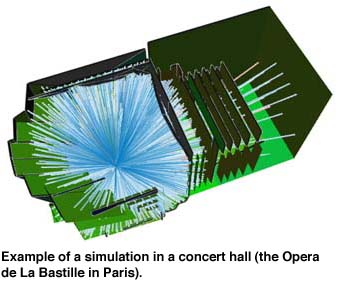ECHO and NARSYS - An Acoustic Modeler and Sound Renderer
by Nicolas Tsingos and Jean-Dominique Gascuel
Computer graphics simulations are now widely used in the field of environmental modelling, for example to evaluate the visual impact of an architectural project on its environment and interactively change its design. Realistic sound simulation is equally important for environmental modelling. At iMAGIS, a joint project of INRIA, CNRS, Joseph Fourier University and the Institut National Polytechnique of Grenoble, we are currently developing an integrated interactive acoustic modelling and sound rendering system for virtual environments. The aim of the system is to provide an interactive simulation of global sound propagation in a given environment and an integrated sound/computer graphics rendering to obtain computer simulated movies of the environment with realistic and coherent soundtracks.
Computer graphics and acoustics research have both given rise to a variety of models which are often based on the same geometrical formalisms. However, despite the growing development of multi-modal simulations, it appears that there is a lack of modelling systems offering integrated design of visual and acoustic properties of dynamic virtual environments and combined computer rendering of image and sound. Our system attempts to fill this gap by reading in a 3D computer model of an environment and providing tools to specify positions and properties of virtual sound sources, microphones and acoustic materials, later used for sound simulation.
 Simulating sound waves propagation is
achieved by the ECHO module using an original hierarchical radiant exchanges
method similar to the radiosity technique used for lighting simulations.
The method accounts for the temporal aspect of sound propagation and both
diffuse and mirror specular reflections which are of primary importance.
We have also developed original techniques to model sound diffraction phenomena.
The hierarchical aspect of our approach allows for tuning the complexity
and realism of the simulation, depending on the application and computing
resources, eg a coarser model is used when less computing power is available.
Thus, the solution can be updated at interactive rates after each modification
of the environment. The sound simulation is completely integrated in an
animation module, used to specify movement of sound sources, microphones,
cameras or any object in the environment over time.
Simulating sound waves propagation is
achieved by the ECHO module using an original hierarchical radiant exchanges
method similar to the radiosity technique used for lighting simulations.
The method accounts for the temporal aspect of sound propagation and both
diffuse and mirror specular reflections which are of primary importance.
We have also developed original techniques to model sound diffraction phenomena.
The hierarchical aspect of our approach allows for tuning the complexity
and realism of the simulation, depending on the application and computing
resources, eg a coarser model is used when less computing power is available.
Thus, the solution can be updated at interactive rates after each modification
of the environment. The sound simulation is completely integrated in an
animation module, used to specify movement of sound sources, microphones,
cameras or any object in the environment over time.
The second part of the system is a sound rendering engine NARSYS (Natural Audio Rendering SYStem) which is used to filter rough sound samples with the solution obtained from the ECHO module in order to produce a soundtrack with realistic sound reverberation, attenuation, Doppler shifting, multi-channel audio output etc. Images rendered from camera viewpoints and sound received by microphones can then be combined to create a realistic animated movie with perfectly coherent soundtrack.
The flexibility of the system makes it well suited for a variety of applications, from generating soundtracks for computer animation movies or interactive sound walkthroughs for virtual environments to interactive acoustic design of concert halls or environmental acoustic planning. A collaboration with the acoustics department of the Centre Scientifique et Technique du Batiment (CSTB) in Grenoble has been established to validate our simulation technique on a variety of environments, including several concert and opera halls like the Opera de la Bastille in Paris. Further information can be found at http://www-imagis.imag.fr/~Nicolas.Tsingos/
Please contact:
Nicolas Tsingos or Jean-Dominique Gascuel iMAGIS/GRAVIR-IMAG
Tel: +33 4 7663 5576
E-mail: Nicolas.Tsingos@imag.fr,
Jean-Dominique.Gascuel@imag.fr
